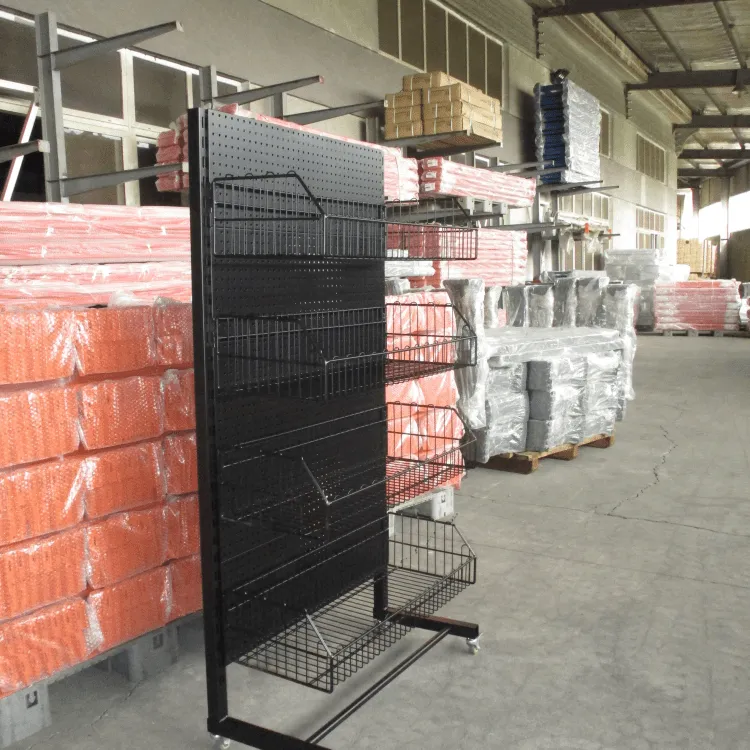The Psychology Behind Supermarket Shelf Layouts
Eye-Level vs. Lower/Upper Shelf Placement Impact
Retailers who want to boost their bottom line need to get inside shoppers' heads when it comes to how stores arrange their shelves. Putting stuff at eye level works wonders because people naturally notice what they can see straight ahead. Studies back this up too many shops report around 30% better sales for items sitting right where customers look first rather than stuck way down low or crammed high above. But this isn't one size fits all situation. Kids tend to gravitate toward toys and snacks placed on lower shelves since that's where they look from standing position. Meanwhile grown ups often check out things higher up maybe because we're taller or just used to looking upward while shopping. There's also something about ownership feeling involved here. When something sits comfortably within reach, it somehow feels less expensive and more worth buying even if price tags tell another story.
How Color and Lighting Influence Purchase Decisions
What goes on inside a store has a big impact on what people buy, especially when it comes to colors and lights around the place. Supermarkets know this well because different hues actually make shoppers feel certain ways and sometimes push them to grab things they didn't plan on buying. Take red for instance, stores put it up near checkout counters all the time since it makes folks feel like they need to act fast before something runs out. Some research backs this up too, showing that particular shades really do help move merchandise off shelves faster than others would. Lighting matters just as much though. When products sit under bright lights, customers notice them better and might think those items look nicer or costlier somehow. Many grocery chains have tested this stuff out already. One chain noticed after putting brighter bulbs above fresh produce sections saw fruit sales jump by double digits overnight. Stores that get good at mixing colors and lighting together end up creating spaces where customers wander longer and spend more money without even realizing why exactly they're doing it.
Role of Shelf Organization in Driving Impulse Purchases
Strategic Positioning of High-Margin Items
Stores often place high profit margin goods right next to checkout counters to boost those spontaneous buys. When customers are already at the register, these displays catch their eye and make them think "I might need this too." Retailers report sales jumps around 40% when done properly. The psychology works wonders here too. Shoppers see limited stock signs or countdown timers and feel that rush to grab something before it's gone. They end up buying stuff they didn't even consider earlier. And then there's the bundling tactic where stores group things that go together, like toothpaste with floss or razors with shaving cream. These packages create that sense of getting more for less, which makes people reach for their wallets even if they weren't planning to spend extra money.
Seasonal Product Rotation Tactics
Keeping seasonal items fresh on store shelves really works wonders for catching what customers want right now and getting them to buy more stuff. Holiday displays especially can give sales a nice kick, sometimes boosting numbers by around 25% based on what we've seen from past seasons. Good seasonal displays need more than just pretty decorations though. Stores mix in related products too, like putting candy next to Halloween costumes or hot cocoa beside Christmas cookies. Many grocers actually tweak their displays constantly throughout the season, watching which products fly off the shelves and which ones sit there collecting dust. They'll move things around based on what shoppers tell them and what sells best at different times. The whole point is matching what's available when people are most excited about buying it, rather than leaving old stuff out long after everyone has lost interest.

Supermarket Shelves as Navigation Guides
Category Zoning and Customer Flow Patterns
How stores organize their products makes a real difference in how customers move around and enjoy shopping. Retailers who sort out their sections properly guide shoppers through the aisles, helping them locate what they need without getting lost. Studies indicate that well-defined areas keep people engaged longer, which means they stay in the store more and might end up buying more stuff. There's also something called a decompression zone that gives shoppers a chance to get comfortable before facing all those product options. Stores that arrange their categories thoughtfully tend to see customers lingering longer while browsing. This extra time often translates into bigger shopping baskets and more money changing hands at checkout.
Signage Effectiveness in Basket Expansion
Store signs really matter when it comes to getting shoppers to spend more money. They point people towards deals or new stuff they might otherwise miss. Research shows different kinds of signs work better in various situations. Digital displays grab attention faster because they move and change, so customers remember what's on sale longer. When designing these signs, big letters are important. Bright colors catch the eye too. Putting them where people naturally walk past certain products works wonders for visibility. Many grocery stores now have touchscreens throughout their aisles that let customers explore recipes while browsing ingredients. These interactive elements turn regular shopping trips into something more interesting. As technology keeps advancing, store signage does more than just show directions anymore. It creates experiences that keep customers coming back and spending more each time they visit.
Impact of Shelf Inventory on Perceived Value
Fullness Perception and Brand Trust
How full those supermarket aisles look really matters when it comes to what people think about the store and whether they trust the brands there. Shoppers tend to see packed shelves as a sign there are lots of choices available, and that makes them feel like the store knows what it's doing. A recent market research report found most consumers connect well stocked displays with better product options and stores they can rely on. From a psychological standpoint, seeing plenty of items just feels good and builds that positive association with the brand. Empty spaces on shelves? That creates all sorts of problems for retailers trying to maintain customer confidence. Supermarkets need smart ways to manage their stock levels so shelves stay looking good while still keeping costs under control. After all, nobody wants to walk past empty spots when they're trying to find something specific.
Out-of-Stock Scenarios and Loyalty Loss
When products are out of stock, it really hurts customer loyalty and often means losing those repeat buyers we all want. The numbers back this up too - around 25% of shoppers will just walk away from our brand completely if they keep finding what they want unavailable. People get frustrated when something isn't there when they need it. They start wondering if we even care about meeting their needs. Understanding how shoppers think matters a lot here. Nobody likes feeling let down after making a purchase decision based on what was supposedly available. Good inventory management makes all the difference though. Keeping track of what's selling and restocking properly prevents these empty shelves situations. Happy customers who find what they need when they need it tend to stick around longer and recommend us to others.
Technological Evolution in Shelf Design
Smart Shelves with Digital Price Tags
Supermarkets are starting to roll out those fancy smart shelves with digital price tags everywhere now, and it's changing how people shop and how stores run their business. These shelves basically use screens instead of paper labels so prices can change instantly. Some stores have seen sales jump around 10% after installing them according to reports. Shoppers get to see prices update right before their eyes, plus any special deals pop up on screen too. For store managers, this means less time running around updating price tags manually. The biggest win? No more confusing situations where different registers show different prices for the same item. Retailers can tweak prices throughout the day depending on what's selling well or what needs clearing out faster. Most analysts think we'll start seeing these digital shelves in almost every grocery store within the next few years as costs come down and shoppers get used to the idea.
Heat Mapping for Shopper Interaction Analysis
Heat maps are changing how we look at what shoppers actually do when they walk through stores and see products on shelves. Retailers using these maps get detailed info about where people stop, linger, or completely ignore certain areas. The patterns become clear after collecting enough data points over time something that was hard to track before digital tools came along. Research shows stores rearranging their shelves based on heat map insights often see better results both in terms of customer interaction and actual sales numbers. For instance, placing seasonal items near high traffic zones tends to work much better than random guessing. Many big supermarkets now rely on heat mapping tech to figure out optimal placement for everything from snack aisles to seasonal displays. These real world applications help managers make smarter choices about where to put products so promotions actually convert into purchases rather than just sitting there collecting dust.
Conclusion: Optimizing Shelves for Behavioral Outcomes
Getting supermarket shelves right based on how people actually shop makes a real difference in boosting sales and keeping customers happy. Retailers who look at what shoppers do and what they want can rearrange their displays to match these patterns. Some stores are now using cool tech stuff too. Heat maps show where customers linger longest while smart shelves track which products get picked up most often. These tools help supermarkets stay ahead of the game when shopping habits shift around. After all, nobody wants to walk past their favorite snacks just because they're stuck behind something nobody buys anymore.
FAQ
Why do products placed at eye level sell more?
Products positioned at eye level tend to capture the attention of consumers more readily, making them appear accessible and desirable. Research indicates that this strategic placement can increase sales by up to 30%, leveraging consumer behavior theories relating to ease of reach and perceived value.
How do colors and lighting influence shopping behavior?
Colors evoke different emotions and can trigger buying impulses. For example, red may create urgency, encouraging impulse purchases. Bright lighting draws attention to products, enhancing their appeal and perceived quality. These elements are used strategically to influence consumer choices and boost sales.
What role does shelf organization play in impulse buying?
Shelf organization, especially near checkout lines or through bundling strategies, can heighten impulse purchases by creating perceived value and urgency. Organized placements can increase sales by up to 40%, encouraging consumers to make additional purchases.
How can out-of-stock items affect consumer loyalty?
Persistent stock shortages can lead to a loss of consumer loyalty, as customers might switch to competing brands. Consistent availability is crucial for maintaining trust and satisfaction, influencing repeat purchases and loyalty.
What is heat mapping in supermarkets?
Heat mapping captures data on shopper interactions with shelf layouts, helping retailers optimize positioning based on customer engagement. This technology enhances shelf layouts for better exposure, increasing sales and improving shopping experiences.

